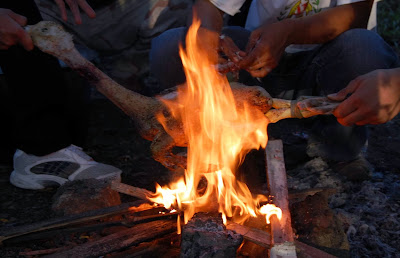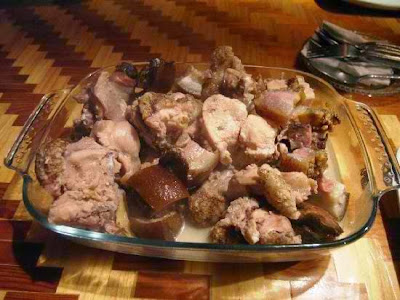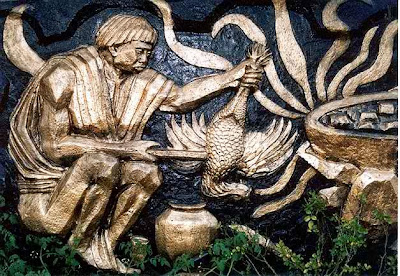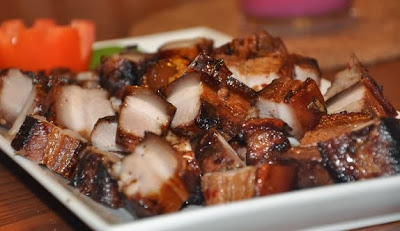PINIKPIKAN – The most popular dish among the Philippine Cordillerans. It is a food preparation composed of chicken meat, soup and vegetables. Because of its distinct savory taste, many people of the lowland Philippines have already included it in their cuisine recipe.
Ingredients and Materials:
- 1 kl live chicken, preferably the common barn chicken or the Philippine native chicken.
- 1/2 kl of peeled chayote/sayote (optional), cut into four pieces lengthwise, Chayote is a green vine plant or its fruit common in the highland Cordilleras.
- 1/2 kl pichay or chinese cabbage (optional), leaves individually parted/separated
- 1/4 kl etag or innasin (optional)
- 2 tablespoons of salt
- 1/4 teaspoon of monosodium glutamate (optional)
- 1 cup chopped leeks
- 6 cloves of crushed garlic
- 3 common size of crushed ginger
- 1/2 cup of quarter-sliced red onion
- 1 cup of tapey (optional), the wine and solid.
- cooking container
- 2 to 3 medium sized bowls
- ladle
- sharp kitchen knife
- chopping knife
- chopping board
- a hard thin but not so light stick about 2 feet in size – for beating the chicken.
- firewood or outdoor gas burner
- clean flat surface – where you can place the chicken while doing with it.
- burn protection gloves – wear it during the chicken dressing, Cordilleran folks do not need to wear them anymore.
Procedures
1. BEATING THE CHICKEN. Well, it involves beating and killing the chicken. But before going to that, I just want to say that it is often when people buy chicken, as much as possible, they do not want to include the bony wings and neck. But the Cordillerans beat the wings and neck until these parts swells and become fleshy, and believe it or not, they tastes good when cooked.Hold tightly together, therefore, the neck, feet, and the other wing in one hand while laying the other wing inside up over the clean flat surface, or you may ask someone to hold and unfold/spread the wing over the flat surface and then use the stick to beat the spread wing flesh from end to end not too soft, but not too hard until the flesh of the wing swells or become bluish. Of course, the chicken squawks so you must harden your grip. Do the same with the other wing. After doing with the wings, hold them and the feet in one hand and lay the neck and head on the flat surface, beat the neck from end to end, and side to side not too hard, but not too soft until it swells and become bluish. When done with the beatings, you must kill the chicken right away by beating hard the back of the head just below the comb. Just one sure blow on the said part can actually kill the chicken instantly.Remember that this is the traditional first step of preparing the pinikpikan. If you do not want to include the blood then you may skip the beatings, instead, bleed it using the sharp kitchen knife. First, go to the drainage or you may provide a container for the blood, hold tightly together the feet and wings and lay the head side up on the surface, slit hard between the neck and the head, you must see the blood spurting out, you can also check inside the incision and cut all the vascular vessels. Hang the chicken over the drainage or blood container until bleeding stops. If you want to skip these procedures then you can proceed to the cooking procedures by using a kilo of chopped roasted/fried chicken, but I should tell you it won’t tastes as good as the traditional pinikpikan. Anyway, pinikpikan means beaten flesh and charred feathers.
2. DRESSING THE CHICKEN USING A SMALL FIRE. Either create a small fire using the firewood or start the gas burner outside the house (this procedure is messy so it be recommended to be done outside). If you are in a cloistered neighborhood or in a place or country that prohibits environmental degradation due to creating fire smokes, then skip this procedure and go directly to the cooking procedure using a ready chicken (chopped roasted or fried chicken). After starting the fire, pluck all the big or primary feathers of the wings and tails and discard them (old folks throw them into the fire). Wear your gloves, hold the feet while you place the chicken body on the fire. Do not stay long on one part so that the skin won’t be burned into carbon. While burning the feathers of the other part, try scraping the charred feathers with the beating stick. Scorch under the wings, the neck, head and the bill. Singe all the parts until feather remnants are removed. Hold the body and burn the feet until the primary layers or scales loosen. Place the chicken on the clean flat surface and remove using your hands the scorched layers of the feet, bill, wattles, and comb. While on the flat surface, check the chicken where and what part you may still need to singe. Note that the old folks do not really have to burn completely all the feathers, they may have already be finished with the dressing even if it is still rough due to some incomplete charring, the new version should be to make it more smoother by charring the feathers completely. When the burning is finished, the color should be from light brown to dark brown, but it is relatively darker if you used firewood.Put off the the fire and bring in the chicken for washing. Wash slightly the whole chicken, open the bill and wash the mouth with running water, scrape it with your finger.

3. PINIKPIKAN WAY OF BUTCHERING AND CHOPPING. After washing the chicken, lay it on the chopping board or on the clean flat surface, chest upside. Hold the right shoulder and with the sharp kitchen knife, make a deep cut slowly between the right shoulder and the neck, slice it down through the cavity (be careful so you won’t harm the crop and other cavity organs) down to the middle and top of the breast bone. Do the same to the left side so that the cut would form a “V” shape. At the vertex of the “V” shape cut, continue the incision (note that the breast bone is soft for the sharp knife and can be easily cut with a little more force) and be careful not to harm any cavity organ especially the gall bladder and the digestive organs. The incision should be directed down to the right side or slanted toward the right side anywhere below the wings to its back, and then cut upward to meet the cut between the shoulder and the neck so that you can separate the right wing, the shoulder, and a small part of the breast. Do the same to the left side. Put separated parts into the cooking container. Lay inside up the remaining part of the chicken and separate the right leg by slicing between the leg and the chest and cutting off the leg bone from the thigh bone, do the same to the other leg, separate the feet from the legs and put them into the cooking container. Create slits at both sides of the thigh, from the cuts down to the part above the anus so that the breast and the back would easily be split apart. Now, you have to do it, hold the neck with one hand and hook the thumb of the other hand on the middle top of the breast bone, and with a little force, split apart the back and the breast. Pull down the breast to reveal the intestines. At this time, you can check the gall bladder if it is short and hidden inside the liver then it is ’sparing,’ but if it is revealed and slightly protruding below the liver then it is ‘yielding.’ You can also review if it is thick or thin before making a wish or decision regarding your immediate future plan. Well, God still knows what is best ahemm…but a person should always try for goodness sake. Now, separate the breast and put it into the cooking container. Cut out the gall bladder carefully (do not spill the gall on the chicken so that it won’t get bitter) and the trachea and discard them. Pull down the esophagus, and remove all the digestive organs and put them in a bowl and set it aside. Take the gizzard from the digestive organ, split it apart flat-wise under a running water and remove the mess inside including the yellowish membrane stuck inside it, then put the gizzard into the cooking container after washing it. Put all the remaining part (the chest organs still intact inside the cavity and the neck still connect the head to the body) into the cooking container. Actually, at this time, some old folks have already finished with their butchering with these eight raw parts of the chicken already separated, they could start cooking it after washing.These parts can actually be best chopped to smaller parts for the servings. Here is one way of chopping the raw parts, take out the parts from the cooking container one after the other for chopping (put them back again after chopping). Using the chopping board and knife, take out the wings and separate the wingettes, shoulders, and the small breast parts. Chop the breast or tenderloin lengthwise into halves, cut each to 3 parts crosswise. Separate the head, comb, and the neck. Take out the cavity organs from the cavity and put them into the cooking container immediately. Separate the rib frame and cut it to 3 parts crosswise. Chop all the remaining parts into considerable sizes. Wash the meat inside the container. After washing, pour two liters of drinking water and cook it.

4. CLEANING THE INTESTINES. While cooking the pinikpikan, you can now take the bowl of intestines. You know, the intestines tastes good, but you can discard them if you like. Suppose you decide to include it in your pinikpikan, then bring it to the running water so that the wastes continuously be washed away while working on it. Untangle the intestines, tear the mesentery and remove the caecas (blind guts) and discard them. Using the small knife, cut the intestines into 6-inch pieces. Put the small knife inside the intestine and rip it lengthwise under the running water to wash away the wastes inside, do the same with the others and put them into a different bowl. Pour three spoonfuls of salt over the torn intestines and mash it for 15 seconds before washing it with water – do it thrice or more before you finally put them into the cooking container.
5. WHILE COOKING. Wash the etag or innasin, you can either chop it or not, and put directly into the cooking container. When the water start to boil, put into the container the garlic, red onion, ginger, tapey, monosodium glutamate, and the salt, let it boil for 30 minutes before you put the sayote, wait for another 10 minutes before you put the chinese cabbage, then let it boil for another 5-8 minutes. Taste the soup, if it is too salty then add more water, otherwise, add more salt.
6. SERVING. Put the vegetables into a bowl and the pinikpikan meat into a separate container. Pour the pinikpikan soup into everyone’s cup and add amount of leeks.Cordillerans consume pinikpikan together with rice during meal time of family reunions, gatherings or feasts. It could also be served as chaser when friends get together for some drinks.










